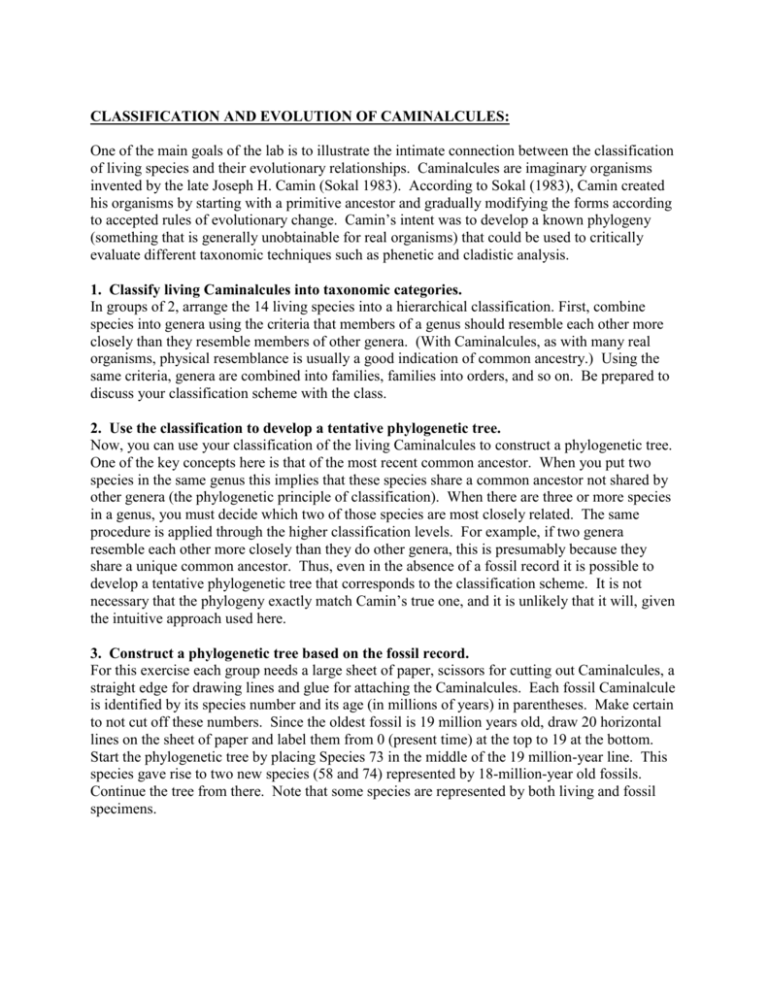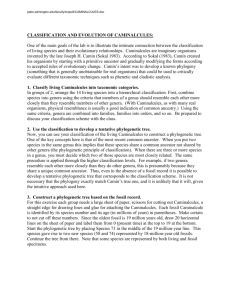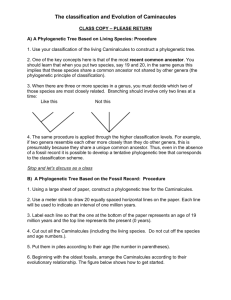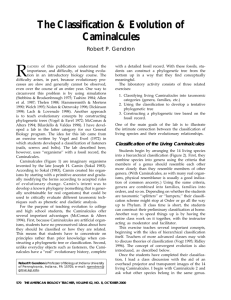LIVING CAMINALCULES:
advertisement

CLASSIFICATION AND EVOLUTION OF CAMINALCULES: One of the main goals of the lab is to illustrate the intimate connection between the classification of living species and their evolutionary relationships. Caminalcules are imaginary organisms invented by the late Joseph H. Camin (Sokal 1983). According to Sokal (1983), Camin created his organisms by starting with a primitive ancestor and gradually modifying the forms according to accepted rules of evolutionary change. Camin’s intent was to develop a known phylogeny (something that is generally unobtainable for real organisms) that could be used to critically evaluate different taxonomic techniques such as phenetic and cladistic analysis. 1. Classify living Caminalcules into taxonomic categories. In groups of 2, arrange the 14 living species into a hierarchical classification. First, combine species into genera using the criteria that members of a genus should resemble each other more closely than they resemble members of other genera. (With Caminalcules, as with many real organisms, physical resemblance is usually a good indication of common ancestry.) Using the same criteria, genera are combined into families, families into orders, and so on. Be prepared to discuss your classification scheme with the class. 2. Use the classification to develop a tentative phylogenetic tree. Now, you can use your classification of the living Caminalcules to construct a phylogenetic tree. One of the key concepts here is that of the most recent common ancestor. When you put two species in the same genus this implies that these species share a common ancestor not shared by other genera (the phylogenetic principle of classification). When there are three or more species in a genus, you must decide which two of those species are most closely related. The same procedure is applied through the higher classification levels. For example, if two genera resemble each other more closely than they do other genera, this is presumably because they share a unique common ancestor. Thus, even in the absence of a fossil record it is possible to develop a tentative phylogenetic tree that corresponds to the classification scheme. It is not necessary that the phylogeny exactly match Camin’s true one, and it is unlikely that it will, given the intuitive approach used here. 3. Construct a phylogenetic tree based on the fossil record. For this exercise each group needs a large sheet of paper, scissors for cutting out Caminalcules, a straight edge for drawing lines and glue for attaching the Caminalcules. Each fossil Caminalcule is identified by its species number and its age (in millions of years) in parentheses. Make certain to not cut off these numbers. Since the oldest fossil is 19 million years old, draw 20 horizontal lines on the sheet of paper and label them from 0 (present time) at the top to 19 at the bottom. Start the phylogenetic tree by placing Species 73 in the middle of the 19 million-year line. This species gave rise to two new species (58 and 74) represented by 18-million-year old fossils. Continue the tree from there. Note that some species are represented by both living and fossil specimens. References cited: Sokal, R.R. 1983. A phylogenetic analysis of the Caminalcules. I. The data base. Systematic Zoology 32: 159–184. Lab modified from: Gendron, R. P. 2000. The classification and evolution of Caminicules. The American Biology Teacher 62: 570-576. ASSIGNMENT (due next week at the start of lab): From the final phylogenetic tree, 1. Identify the most recent ancestor of any two species. 2. Provide an example of convergent evolution. 3. Provide an example of a vestigal structure. 4. Provide an example of evolutionary stasis. 5. Provide an example of rapid adaptive radiation. Be certain to fully explain why each example that you provide illustrates the relevant principle. (Please format using Times New Roman 12-point font, with single spacing and 1-inch margins.) LIVING CAMINALCULES: FOSSIL CAMINALCULES: Numbers in parentheses indicate the age of each fossil in millions of years.











